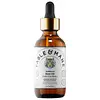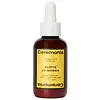What's inside
What's inside
 Key Ingredients
Key Ingredients

 Benefits
Benefits

 Concerns
Concerns

 Ingredients Side-by-side
Ingredients Side-by-side

Caprylic/Capric Triglyceride
MaskingCarthamus Tinctorius Seed Oil
MaskingParfum
MaskingSesamum Indicum Seed Oil
EmollientWithania Somnifera Root Extract
Skin ConditioningPhyllanthus Emblica Fruit Extract
HumectantBacopa Monnieri Leaf Extract
Skin ConditioningEclipta Prostrata Extract
Skin ConditioningSimmondsia Chinensis Seed Oil
EmollientRicinus Communis Seed Oil
MaskingPueraria Lobata Root Extract
HumectantTribulus Terrestris Root Extract
Skin ConditioningStereospermum Suaveolens Root Extract
Skin ConditioningSolanum Xanthocarpum Root Extract
MaskingSolanum Indicum Root Extract
Skin ConditioningPremna Serratifolia Root Extract
Skin ConditioningGlycyrrhiza Glabra Root Extract
BleachingBeta-Sitosterol
Emulsion StabilisingGmelina Arborea Root Extract
Skin ConditioningDesmodium Gangeticum Root Extract
Skin ConditioningAegle Marmelos Root Extract
Skin ConditioningSqualene
EmollientOlea Europaea Fruit Oil
MaskingVitis Vinifera Seed Oil
EmollientTocopherol
AntioxidantPhenoxyethanol
PreservativeBenzyl Salicylate
PerfumingIsoeugenol
PerfumingLinalool
PerfumingCaprylic/Capric Triglyceride, Carthamus Tinctorius Seed Oil, Parfum, Sesamum Indicum Seed Oil, Withania Somnifera Root Extract, Phyllanthus Emblica Fruit Extract, Bacopa Monnieri Leaf Extract, Eclipta Prostrata Extract, Simmondsia Chinensis Seed Oil, Ricinus Communis Seed Oil, Pueraria Lobata Root Extract, Tribulus Terrestris Root Extract, Stereospermum Suaveolens Root Extract, Solanum Xanthocarpum Root Extract, Solanum Indicum Root Extract, Premna Serratifolia Root Extract, Glycyrrhiza Glabra Root Extract, Beta-Sitosterol, Gmelina Arborea Root Extract, Desmodium Gangeticum Root Extract, Aegle Marmelos Root Extract, Squalene, Olea Europaea Fruit Oil, Vitis Vinifera Seed Oil, Tocopherol, Phenoxyethanol, Benzyl Salicylate, Isoeugenol, Linalool
Limnanthes Alba Seed Oil
Skin ConditioningCoconut Alkanes
EmollientSalvia Hispanica Seed Oil
MoisturisingOrbignya Oleifera Seed Oil
EmollientBrassica Campestris Seed Oil
Skin ConditioningOenocarpus Bataua Fruit Oil
EmollientCrambe Abyssinica Seed Oil Phytosterol Esters
EmulsifyingCoco-Caprylate/Caprate
EmollientOryza Sativa Bran Oil
EmollientPassiflora Edulis Seed Oil
EmollientOryza Sativa Bran Extract
Skin ConditioningParfum
MaskingTheobroma Grandiflorum Seed Butter
Skin ConditioningAloe Barbadensis Leaf Extract
EmollientRicinus Communis Seed Oil
MaskingEuterpe Oleracea Fruit Oil
Skin ConditioningHelianthus Annuus Extract
EmollientTocopherol
AntioxidantRosmarinus Officinalis Leaf Extract
AntimicrobialLimnanthes Alba Seed Oil, Coconut Alkanes, Salvia Hispanica Seed Oil, Orbignya Oleifera Seed Oil, Brassica Campestris Seed Oil, Oenocarpus Bataua Fruit Oil, Crambe Abyssinica Seed Oil Phytosterol Esters, Coco-Caprylate/Caprate, Oryza Sativa Bran Oil, Passiflora Edulis Seed Oil, Oryza Sativa Bran Extract, Parfum, Theobroma Grandiflorum Seed Butter, Aloe Barbadensis Leaf Extract, Ricinus Communis Seed Oil, Euterpe Oleracea Fruit Oil, Helianthus Annuus Extract, Tocopherol, Rosmarinus Officinalis Leaf Extract
 Reviews
Reviews

Alternatives
Ingredients Explained
These ingredients are found in both products.
Ingredients higher up in an ingredient list are typically present in a larger amount.
Parfum is a catch-all term for an ingredient or more that is used to give a scent to products.
Also called "fragrance", this ingredient can be a blend of hundreds of chemicals or plant oils. This means every product with "fragrance" or "parfum" in the ingredients list is a different mixture.
For instance, Habanolide is a proprietary trade name for a specific aroma chemical. When used as a fragrance ingredient in cosmetics, most aroma chemicals fall under the broad labeling category of “FRAGRANCE” or “PARFUM” according to EU and US regulations.
The term 'parfum' or 'fragrance' is not regulated in many countries. In many cases, it is up to the brand to define this term.
For instance, many brands choose to label themselves as "fragrance-free" because they are not using synthetic fragrances. However, their products may still contain ingredients such as essential oils that are considered a fragrance by INCI standards.
One example is Calendula flower extract. Calendula is an essential oil that still imparts a scent or 'fragrance'.
Depending on the blend, the ingredients in the mixture can cause allergies and sensitivities on the skin. Some ingredients that are known EU allergens include linalool and citronellol.
Parfum can also be used to mask or cover an unpleasant scent.
The bottom line is: not all fragrances/parfum/ingredients are created equally. If you are worried about fragrances, we recommend taking a closer look at an ingredient. And of course, we always recommend speaking with a professional.
Learn more about ParfumRicinus Communis Seed Oil is the INCI name for castor oil.
Castor Oil helps moisturize the skin. It is rich in a fatty acid called ricinoleic acid. This fatty acid helps prevent moisture loss on the skin. This helps keep your skin soft and hydrated. Ricinoleic acid also has anti-inflammatory and pain reducing properties.
Besides hydrating the skin, castor oil is also used to hydrate hair. By keeping the hair shaft moisturized, breakage is decreased. More studies are needed to show castor oil's effective on stimulating hair growth.
Castor oil is created by cold-pressing castor seeds and then purifying the oil with heat. It was used in Ancient Egypt as fuel in lamps and to help treat eye irritation.
The term 'fragrance' is not regulated in many countries. In many cases, it is up to the brand to define this term. For instance, many brands choose to label themselves as "fragrance-free" because they are not using synthetic fragrances. However, their products may still contain ingredients such as essential oils that are considered a fragrance.
Learn more about Ricinus Communis Seed OilTocopherol (also known as Vitamin E) is a common antioxidant used to help protect the skin from free-radicals and strengthen the skin barrier. It's also fat soluble - this means our skin is great at absorbing it.
Vitamin E also helps keep your natural skin lipids healthy. Your lipid skin barrier naturally consists of lipids, ceramides, and fatty acids. Vitamin E offers extra protection for your skin’s lipid barrier, keeping your skin healthy and nourished.
Another benefit is a bit of UV protection. Vitamin E helps reduce the damage caused by UVB rays. (It should not replace your sunscreen). Combining it with Vitamin C can decrease sunburned cells and hyperpigmentation after UV exposure.
You might have noticed Vitamin E + C often paired together. This is because it is great at stabilizing Vitamin C. Using the two together helps increase the effectiveness of both ingredients.
There are often claims that Vitamin E can reduce/prevent scarring, but these claims haven't been confirmed by scientific research.
Learn more about Tocopherol